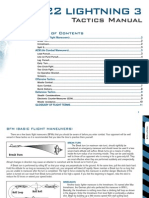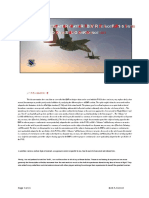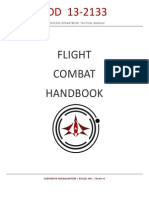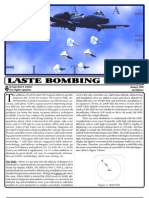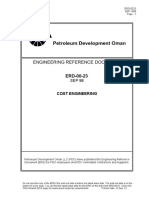74th VTS Basic Flight Maneuvers Change 2 PDF
74th VTS Basic Flight Maneuvers Change 2 PDF
Uploaded by
Miguel SanchezCopyright:
Available Formats
74th VTS Basic Flight Maneuvers Change 2 PDF
74th VTS Basic Flight Maneuvers Change 2 PDF
Uploaded by
Miguel SanchezOriginal Title
Copyright
Available Formats
Share this document
Did you find this document useful?
Is this content inappropriate?
Copyright:
Available Formats
74th VTS Basic Flight Maneuvers Change 2 PDF
74th VTS Basic Flight Maneuvers Change 2 PDF
Uploaded by
Miguel SanchezCopyright:
Available Formats
74th vTraining Squadron
Basic Flight Maneuvers
BASIC FLIGHT MANEUVERS
Prepared by Snoopy (paulrkiii)
NOTE
Members of the 476th vFG should review applicable operation instructions for latest
requirements.
NON CLASSIFIED
FOR PUBLIC RELEASE
PUBLISHED UNDER AUTHORITY OF THE 476TH vFG COMMAND STAFF
www.476thvfightergroup.com
476th vTraining Squadron
Basic Flight Maneuvers
INTRODUCTION
CONTENT
This document is for DCS, specifically fixed wing fighters basic flight maneuvers.
Information to create this guide was pulled from various real world USAF and NATO
documentation.
Any reference to broadcasting on a specific radio channel while in a multiplayer (MP)
server is implied TARS is in use.
TABLE OF CONTENTS
PURPOSE...
TASK....
AILERON ROLL.....
BARREL ROLL...
LAZY EIGHT...
CHANDELLE..
LOOP
CUBAN EIGHT...
IMMELMANN..
SPLIT S.
2
2
2
3
4
5
6
7
8
9
ATTACHMENT 1, BASIC MANEUVERS QUICK REFERENCE...
10
1 AUG 2012
CHANGE 2
476th vTraining Squadron
Basic Flight Maneuvers
A-10 BASIC FLIGHT MANEUVERS
Purpose
To introduce pilots to A-10C basic flight maneuvers.
Tasks
Upon completion of this Volume pilots should be able safely execute basic A-10C
Thunderbolt II.
Aileron Roll - a 360-degree roll about the longitudinal axis of the aircraft. The
maneuver is complete when the wings are again parallel to the horizon.
Attain briefed entry parameters. Smoothly raise the nose to 20 to 30 degrees
nose-high pitch attitude. Relax back stick pressure and stop nose track, then roll
the aircraft left or right using coordinated aileron and rudder. The nose of the
aircraft does not roll around a specific point in the roll. As the aircraft approaches
wings level, neutralize the rudder and aileron, and return to level flight.
1 AUG 2012
CHANGE 2
476th vTraining Squadron
Basic Flight Maneuvers
Barrel Roll - a coordinated roll in which the nose of the aircraft describes a circle
around a point on or near the horizon. The maneuver is complete when the aircraft is
wings level, abeam the reference point on the original side, at approximately entry
airspeed
Select a reference point, such as a cloud or landmark, on or slightly above the
horizon. Set briefed power and attain briefed entry airspeed with the nose of the
aircraft below the horizon. Begin a coordinated turn in the opposite direction of
the desired roll, as necessary, to place the aircraft up to 45 degrees to the side of
the reference point. Roll out of the initial turn so the wings are level as the aircraft
passes through the horizon. The distance to the side of the reference point
depends on the initial turn and speed of the rollout. The distance from the
reference point defines the size of the barrel roll, and it should remain constant
throughout the maneuver. From level flight, increase pitch and bank. As the bank
reaches 90 degrees, the aircraft should be directly above the reference point.
Passing 90 degrees of bank, relax some back pressure and increase aileron
deflection to continue the roll with reduced airspeed. Back pressure must be
reduced compared to the first quarter of the roll because gravity is now in the
same direction as the lift vector (downward) when inverted. Plan the roll so the
wings become level just as the aircraft reaches the inverted level-flight attitude.
The aircraft should be displaced from the reference point the same distance as at
the beginning of the maneuver.
Continue the roll and apply increased elevator pressure. As the bank again
reaches the 90 degrees at the bottom of the maneuver, the nose track should
continue to arc around the reference point. In this last quarter of roll, increase
back stick pressure because gravity is now working against the lift vector.
1 AUG 2012
CHANGE 2
476th vTraining Squadron
Basic Flight Maneuvers
Maintain coordinated control pressure to continue the roll so the nose completes
the circle around the reference point, ending up wings level at the horizon.
Lazy Eight. - a slow, lazy maneuver that describes a horizontal figure eight at the
horizon. The horizon line bisects this figure eight lengthwise. Pitch, bank, and airspeed
constantly change. The maneuver is complete after two 180-degree turns with the
aircraft in level flight.
Begin in straight-and-level flight with briefed entry airspeed and power setting.
Select the desired reference point on the horizon or ground, and align the aircraft
so the reference point is directly off a wingtip. Blend aileron, rudder, and elevator
pressures simultaneously to start a gradual climbing turn in the direction of the
reference point. The initial bank should be very shallow to prevent excessive turn
rate. As the nose is raised, the airspeed decreases, causing the rate of turn to
increase. Time the turn and pull-up so the nose reaches the highest pitch attitude
(approximately 45 degrees) when the aircraft has turned 45 degrees or halfway
to the reference point. Use outside references and the attitude indicator to crosscheck these pitch-and-bank attitudes. Bank continues to increase as the nose
falls. The aircraft should be pointed at the reference point as a maximum bank of
80 to 90 degrees is reached and the nose reaches the horizon. The lowest
airspeed occurs just as the nose reaches the horizon (approximately 100 knots
below entry airspeed).
Do not freeze the pitch or bank at the horizon. Passing the horizon, let the nose
fall, and begin rolling out of bank. The second half of the leaf (nose below
horizon) should be symmetric and approximately the same size as the first half
1 AUG 2012
CHANGE 2
476th vTraining Squadron
Basic Flight Maneuvers
(nose above the horizon). The bank should change at the same rate as during
the nose-up portion of the leaf. When the aircraft has turned 135 degrees, the
nose should be at its lowest attitude and the bank should be 45 degrees.
Continue blending control stick and rudder pressure to simultaneously raise the
nose and level the wings. Monitor the progress of the turn by checking the
outside reference point (off opposite shoulder from maneuver start). The aircraft
should be wings level at entry airspeed as the nose reaches the horizon, having
completed 180 degrees of turn. Without pausing, begin the second leaf in the
opposite direction of the first.
Chandelle - a precision, constant bank 180-degree steep climbing turn that
achieves a maximum gain of altitude for a given power setting. The maneuver is
complete after 180 degrees of turn.
Begin wings level, 15 degrees NL with briefed power setting but below briefed
entry airspeed. When airspeed reaches briefed entry airspeed, blend rudder,
aileron, and elevator pressure simultaneously to begin a climbing turn, using
approximately 3 Gs. Increase bank to 60 degrees and keep the nose track rising
at a uniform rate. The nose should describe a straight line diagonal to the
horizon. The nose should pass through the horizon at 60 degrees bank with 30 to
45 degrees of turn complete. Check the amount of turn by using outside
references. Once the nose is above the horizon, the vertical component of lift
decreases, and considerably more back pressure is required to keep the nose
rising at a uniform rate. These variables in the pitch angle, airspeed, and the
vertical component of lift require constant changes in control pressures to keep
the nose rising at a constant rate. At the 135-degree point in the turn, start the
rollout but keep the nose rising. Monitor the amount of turn remaining before
1 AUG 2012
CHANGE 2
476th vTraining Squadron
Basic Flight Maneuvers
reaching the 180-degree point by checking outside references. Time the rollout
so the wings become level as the nose reaches the highest pitch attitude
(approximately 40 to 45 degrees) at the 180-degree point. When the maneuver is
complete (180 degrees of turn), lower the nose to the horizon or perform a nosehigh recovery.
If the rate of climb is too fast, and the aircraft approaches stall before turning 180
degrees discontinue the maneuver by performing a nose-high recovery. If the
rate of pitch change is too slow, the 180-degree point may be reached before the
maximum pitch attitude is attained. When starting the maneuver, the rate of rollin is faster than the rate of pull-up (60 degrees bank change, 15 degrees pitch
change).
Loop - a 360-degree turn in the vertical plane with constant heading and nose track.
Because it is executed in a single plane, the elevator is the principle control surface.
Ailerons and rudder are used to maintain directional control and coordinated flight. The
maneuver is complete when wings are level at the horizon on the same heading as at
entry.
Begin straight-and-level to 20 degrees NL, with briefed entry airspeed and power
setting. Smoothly pull the nose up using 3 to 4 Gs. When the forward view of the
horizon disappears in the pull-up, maintain wings level (straight pull) by keeping
the wingtips equidistant from the horizon. Back stick pressure and G loading
decrease to maintain a constant nose track as airspeed decreases; however, aft
control stick displacement increases. Right rudder pressure is required to keep
the aircraft coordinated as airspeed decreases. Insufficient rudder, as airspeed
1 AUG 2012
CHANGE 2
476th vTraining Squadron
Basic Flight Maneuvers
decreases, may allow the nose to deviate up to 30 degrees off desired track.
Airspeed should be approximately 100 to 120 KIAS wings level inverted (over the
top). Pull straight through the vertical and increase G loading to maintain a
constant nose track until a level flight attitude is reached. Maintain coordinated
rudder as the airspeed increases in the dive.
Cuban Eight - Each half of this maneuver is a combination of a slightly modified
loop and Immelmann. The first portion of each leaf is approximately the first five-eighths
of a loop followed by a half roll. The pull and roll is then repeated in the opposite
direction. The maneuver looks like an 8 on its side. The maneuver is complete at
level flight, with entry airspeed and on original heading.
Begin in straight-and-level flight, with briefed entry airspeed and power setting.
Perform the first part of a loop until over the top, inverted. After passing through
inverted-level flight, continue the loop until approaching 45 degrees NL, inverted.
Execute a coordinated half roll in either direction. Relax the elevator pressure to
keep the nose track in the same vertical plane. After completing the half roll,
maintain 45 degrees NL until beginning the pull-up for the second half of the
maneuver. Plan to initiate the pull-up to attain briefed entry airspeed at the
horizon (passing through level flight). To accomplish this, begin the pull-up
approximately 35 to 40 KIAS below briefed entry airspeed (the airspeed lead
point is approximately equal to number of degrees of NL pitch). Continue the pullup into another loop entry. The second half of the Cuban Eight is identical to the
first except the roll is in the opposite direction.
1 AUG 2012
CHANGE 2
476th vTraining Squadron
Basic Flight Maneuvers
Immelmann - half loop followed by a half roll, all flown in the same vertical plane.
The maneuver is complete after a momentary pause in level flight with wings level on an
opposite heading from entry.
Begin in straight-and-level flight, with briefed entry airspeed and power setting.
Smoothly pull the nose up using 3 to 4 Gs. When the forward view of the horizon
disappears in the pull-up, maintain wings level (straight pull) by keeping the
wingtips equidistant from the horizon. Back stick pressure and G loading
decrease to maintain a constant nose track as airspeed decreases; however, aft
control stick displacement increases. Moderate right rudder pressure is required
to keep the aircraft coordinated as airspeed decreases. Insufficient rudder, as
airspeed decreases, may allow the nose to deviate up to 30 degrees off desired
track. As the aircraft reaches a point approximately 10 degrees above the
horizon inverted, relax back stick pressure and apply aileron with coordinated
rudder in either direction to initiate a roll to level flight. The maneuver is complete
after a momentary pause in level flight following the rollout.
1 AUG 2012
CHANGE 2
476th vTraining Squadron
Basic Flight Maneuvers
Split S - combines the first half of an aileron roll with the last half of a loop. It
demonstrates how much altitude is lost if recovery from inverted flight is attempted by
pulling through the horizon. The aircraft climbs during entry and descends during
recovery. The maneuver is complete when the aircraft returns to level flight.
Begin in straight-and-level flight approximately 40 KIAS above briefed entry
airspeed. Briefed power setting may be established any time before or during the
half roll. Raise the nose to approximately a 20-degree pitch attitude (FCP clock
on the horizon). When the airspeed is approximately 20 KIAS above briefed entry
airspeed, roll the aircraft to the wings-level, inverted attitude. Apply back
pressure to bring the nose through the horizon. To avoid excessive G and
airspeed at the bottom, attempt to max perform once the nose passes the
horizon. Airspeed and G loading (approximately 3 to 4 Gs) increase during the
pullout. Perform a proper anti-G strain.
1 AUG 2012
CHANGE 2
476th vTraining Squadron
Basic Flight Maneuvers
ATTACHMENT 1
BASIC MANUEVER QUICK REFERENCE
Aileron Roll
------------------------------------------------------------------Barrel Roll
-------------------------------------------------------------------
1 AUG 2012
CHANGE 2
10
476th vTraining Squadron
Basic Flight Maneuvers
Lazy Eight
------------------------------------------------------------------Chandelle
-------------------------------------------------------------------
1 AUG 2012
CHANGE 2
11
476th vTraining Squadron
Basic Flight Maneuvers
Loop
------------------------------------------------------------------Cuban Eight
-------------------------------------------------------------------
1 AUG 2012
CHANGE 2
12
476th vTraining Squadron
Basic Flight Maneuvers
Immelmann
------------------------------------------------------------------Split-S
1 AUG 2012
CHANGE 2
13
You might also like
- F-14 Case I Landing Tips Victory 205 Rev 2Document12 pagesF-14 Case I Landing Tips Victory 205 Rev 2Dave GoSky100% (2)
- Hawgsmoke MilsDocument8 pagesHawgsmoke MilsIvan FriganovicNo ratings yet
- Aeroplane Flight Training: Lesson Plans for Students & Instructors With Questions - Plus a Lot MoreFrom EverandAeroplane Flight Training: Lesson Plans for Students & Instructors With Questions - Plus a Lot MoreRating: 3 out of 5 stars3/5 (2)
- TacticsDocument20 pagesTacticsfacilmesmoNo ratings yet
- 74th VTS Formation Guide Change 3 PDFDocument29 pages74th VTS Formation Guide Change 3 PDFMiguel Sanchez100% (2)
- A 10c Operations ProceduresDocument90 pagesA 10c Operations ProceduresYifan GuNo ratings yet
- Fighter Pilot 101: Edited By: LT Col L. O. "Moe" Grady 56 Operations GroupDocument31 pagesFighter Pilot 101: Edited By: LT Col L. O. "Moe" Grady 56 Operations GroupGuillermoNo ratings yet
- Air Combat - 325th Fighter Group (Virtual) Air Combat Maneuver and Tactics ManualDocument72 pagesAir Combat - 325th Fighter Group (Virtual) Air Combat Maneuver and Tactics Manual7dph6qbb2gNo ratings yet
- 476th VFG A-10C Flight Crew Checklist Change 10 PDFDocument129 pages476th VFG A-10C Flight Crew Checklist Change 10 PDFSérgio SantanaNo ratings yet
- Section 1 Section 2: B V R B F MDocument36 pagesSection 1 Section 2: B V R B F MBernardo Alvarado100% (1)
- BVR F15.fr - enDocument25 pagesBVR F15.fr - endundun92100% (1)
- Redstar Pilots Association MANUAL BasicDocument100 pagesRedstar Pilots Association MANUAL BasicChristiano Pereira de Oliveira100% (1)
- QRH PC12NGDocument148 pagesQRH PC12NGLane ReisNo ratings yet
- How To Z Diagrams PDFDocument2 pagesHow To Z Diagrams PDFEmiliano German ChavesNo ratings yet
- Flight Combat Handbook: Defense Department Tactical ManualDocument29 pagesFlight Combat Handbook: Defense Department Tactical ManualImaginary_star100% (2)
- 476th VFG Weapon Fact Sheet 1Document7 pages476th VFG Weapon Fact Sheet 1Tyler FernandoNo ratings yet
- IRIS F-15E Mudhen Driver Product HandbookDocument166 pagesIRIS F-15E Mudhen Driver Product HandbookJuan Carlos SrafanNo ratings yet
- DCS A-10c Warthog ChecklistDocument130 pagesDCS A-10c Warthog ChecklistAKNo ratings yet
- MiG-29 v2.01 ChecklistsDocument7 pagesMiG-29 v2.01 ChecklistsDave91100% (1)
- Basic Prosecution of The BVR FightDocument19 pagesBasic Prosecution of The BVR FightporkeaterNo ratings yet
- IFR SyllabusDocument5 pagesIFR SyllabusAlNo ratings yet
- Afi11 2f 16v3 - 944fwsup1Document21 pagesAfi11 2f 16v3 - 944fwsup1yoyoNo ratings yet
- Hogsmoke Ifg 2010Document24 pagesHogsmoke Ifg 2010zacklawsNo ratings yet
- Flight Training Instruction: Naval Air Training CommandDocument112 pagesFlight Training Instruction: Naval Air Training CommandSky manNo ratings yet
- T-45 ResearchDocument1 pageT-45 ResearchAnonymous n605TvNbNo ratings yet
- Jarppl c152 Exercise NotesDocument74 pagesJarppl c152 Exercise NotesMartin NgugiNo ratings yet
- Aerodynamics and Theory of Flight, Forces of Flight, Lift, Weight, Thrust, DragDocument14 pagesAerodynamics and Theory of Flight, Forces of Flight, Lift, Weight, Thrust, DragMohammad ChessterNo ratings yet
- I Derby ERDocument2 pagesI Derby ERManuel SolisNo ratings yet
- Basic Employment Manual F 16C RoKAFDocument598 pagesBasic Employment Manual F 16C RoKAFKANGMIN LEENo ratings yet
- DCS AMRAAM Dev Report ENDocument7 pagesDCS AMRAAM Dev Report ENdundun92No ratings yet
- F-16d BLK 50 AlbaceteDocument40 pagesF-16d BLK 50 AlbacetedimNo ratings yet
- Laste A 10 Bombing GuideDocument6 pagesLaste A 10 Bombing Guideflybull100% (1)
- On Landings Part IDocument16 pagesOn Landings Part IspamhappyNo ratings yet
- Flight Training Instruction Primary Formation T-34cDocument118 pagesFlight Training Instruction Primary Formation T-34cNeilGWilson100% (1)
- ATM Study GuideDocument243 pagesATM Study GuidechicovwNo ratings yet
- CNATRAINST 1542 139 T 45A Jet Transition Strike Flight Instructor Training Curriculum 10 Oct 2000Document214 pagesCNATRAINST 1542 139 T 45A Jet Transition Strike Flight Instructor Training Curriculum 10 Oct 2000Anonymous d8N4gq100% (1)
- USFS Aviation Accident HistoryDocument112 pagesUSFS Aviation Accident HistoryJ HevesiNo ratings yet
- Mil Mi-24 HindDocument3 pagesMil Mi-24 HindOle WeierNo ratings yet
- Air Campaign Planning HandbookDocument91 pagesAir Campaign Planning Handbookjarod437No ratings yet
- Night VFR Flying: Risk Management Decision PathDocument2 pagesNight VFR Flying: Risk Management Decision PathChirca Florentin100% (1)
- FM 1-514 Principles of Helicopter FlightDocument59 pagesFM 1-514 Principles of Helicopter Flightwawaland100% (1)
- Judy Endicott - Raid On Libya Operation ELDORADO CANYONDocument11 pagesJudy Endicott - Raid On Libya Operation ELDORADO CANYONAndrea MatteuzziNo ratings yet
- Helicopter AerodynamicsDocument374 pagesHelicopter Aerodynamicsdouglasjames1968100% (2)
- 65CB2039 5056 A318 A86951c16ad830c1Document41 pages65CB2039 5056 A318 A86951c16ad830c1expairtiseNo ratings yet
- Navigation Flying TechniqueDocument24 pagesNavigation Flying TechniqueDipankar BhattacharjeeNo ratings yet
- Appendix B Intelligence Preparation of The Battlefield ProductsDocument15 pagesAppendix B Intelligence Preparation of The Battlefield ProductsdonguieNo ratings yet
- Mirage F1 Flight ManualDocument234 pagesMirage F1 Flight ManualChris ChoNo ratings yet
- F15 PDFDocument89 pagesF15 PDFJJNo ratings yet
- 167th Defensive ManeuveringDocument22 pages167th Defensive ManeuveringTo. ANo ratings yet
- 25VFS OI 07-A-10 A-10c Ground Weapon EmploymentDocument58 pages25VFS OI 07-A-10 A-10c Ground Weapon EmploymentAlessandro MigliardiNo ratings yet
- AMRAAM - When To Chuck SpearsDocument11 pagesAMRAAM - When To Chuck SpearsDave GoSky100% (1)
- 476th VFG Weapon Fact Sheet 5Document4 pages476th VFG Weapon Fact Sheet 5Miguel SanchezNo ratings yet
- Army Aviation Digest - Oct 1975Document50 pagesArmy Aviation Digest - Oct 1975Aviation/Space History LibraryNo ratings yet
- BVR Timeline SOP (Short)Document5 pagesBVR Timeline SOP (Short)knchozNo ratings yet
- 7197eed01 - The Use of Night Vision Goggles (NVG) During Nato Air Transport OperationsDocument15 pages7197eed01 - The Use of Night Vision Goggles (NVG) During Nato Air Transport OperationsMarta100% (1)
- Csweapon ManualDocument39 pagesCsweapon ManualMehedi HasanNo ratings yet
- Simple Guide To Formation FlyingDocument13 pagesSimple Guide To Formation FlyingSimo AliNo ratings yet
- From Auster to Apache: The History of 656 Squadron RAF/ACC 1942–2012From EverandFrom Auster to Apache: The History of 656 Squadron RAF/ACC 1942–2012No ratings yet
- 476th VFG Weapon Fact Sheet 5Document4 pages476th VFG Weapon Fact Sheet 5Miguel SanchezNo ratings yet
- 74th VTS A-10 Air-to-Air Refueling Guide Change 1 PDFDocument11 pages74th VTS A-10 Air-to-Air Refueling Guide Change 1 PDFMiguel SanchezNo ratings yet
- Exz110 enDocument242 pagesExz110 enMiguel SanchezNo ratings yet
- Sycj PDFDocument3 pagesSycj PDFMiguel Sanchez100% (1)
- 08 Int Sid-Star ChartDocument12 pages08 Int Sid-Star ChartMiguel SanchezNo ratings yet
- 476th VFG Weapon Fact Sheet 5Document4 pages476th VFG Weapon Fact Sheet 5Miguel SanchezNo ratings yet
- Erd 00 23Document39 pagesErd 00 23kattabommanNo ratings yet
- Ruukki Hot Rolled Steels Processing of Material WeldingDocument11 pagesRuukki Hot Rolled Steels Processing of Material Weldingprince5621No ratings yet
- ReadmeDocument2 pagesReadmeCarlo Gieraldo Rossetti GuitrónNo ratings yet
- Trail & Rossland - Pennywise July 2, 2013Document48 pagesTrail & Rossland - Pennywise July 2, 2013Pennywise PublishingNo ratings yet
- HITACHI Roller ChainsDocument66 pagesHITACHI Roller ChainsOscar Eduardo Gonzalez GiraldoNo ratings yet
- CS User ManualDocument53 pagesCS User ManualKhushal Juneja75% (24)
- Airborne Imaging in 2011Document29 pagesAirborne Imaging in 2011Emil EterovićNo ratings yet
- FLIR-katalog 01 08Document9 pagesFLIR-katalog 01 08Sameer NasnodkarNo ratings yet
- Sbc302 Feb 2008 FinalDocument36 pagesSbc302 Feb 2008 FinalUğur DündarNo ratings yet
- ITPDocument4 pagesITP14102001No ratings yet
- Azipod Technical Presentation PDFDocument23 pagesAzipod Technical Presentation PDFIngeniumDemNo ratings yet
- 01VE - MPS-C Distributing StationDocument1 page01VE - MPS-C Distributing StationAlexita LopezNo ratings yet
- Quaternions & IMU Sensor Fusion With Complementary Filtering PDFDocument51 pagesQuaternions & IMU Sensor Fusion With Complementary Filtering PDFjordimon1234No ratings yet
- Nissan Murano Engine Air Intake DuctDocument8 pagesNissan Murano Engine Air Intake DuctenkcyongNo ratings yet
- Multilateration (MLAT) Concept of Use: Internatonal Civil Aviation Organization Asia and Pacific OfficeDocument19 pagesMultilateration (MLAT) Concept of Use: Internatonal Civil Aviation Organization Asia and Pacific Officertomka100% (1)
- Customised Service and Individual Solutions: Welcome To EMSTECDocument23 pagesCustomised Service and Individual Solutions: Welcome To EMSTEClpczyfansNo ratings yet
- AV-NC-F01 Non-Conformance Report Iss 1Document1 pageAV-NC-F01 Non-Conformance Report Iss 1Kevin DeLimaNo ratings yet
- ISDS 351 - Exam 2Document5 pagesISDS 351 - Exam 2jay baoNo ratings yet
- Supplier Quality Management SystemDocument13 pagesSupplier Quality Management SystemSead ZejnilovicNo ratings yet
- Forest Fire Management System: Ministry of ForestsDocument4 pagesForest Fire Management System: Ministry of ForestsDragana MilosevicNo ratings yet
- Current Carrying CapacityDocument106 pagesCurrent Carrying Capacityshivender777No ratings yet
- Explosion Protection DocumentDocument12 pagesExplosion Protection Documentbiglee82No ratings yet
- Design Criteria Facility STD Manual 8-15-97Document358 pagesDesign Criteria Facility STD Manual 8-15-97aadasNo ratings yet
- Software System Safety HandbookDocument247 pagesSoftware System Safety HandbookbtjajadiNo ratings yet
- Microsoft Dynamics AX 2012 R3Document11 pagesMicrosoft Dynamics AX 2012 R3Sildi MetaNo ratings yet
- 2473 1 7825 1 10 20210421Document10 pages2473 1 7825 1 10 20210421Izzal AdytyaNo ratings yet
- ch13 SDLCDocument45 pagesch13 SDLCCarmina Pangan100% (1)
- Usability Test of Google Sheets and ExcelDocument19 pagesUsability Test of Google Sheets and Excelapi-457766991No ratings yet
- Applications Guideline-Flashing (Water)Document2 pagesApplications Guideline-Flashing (Water)strahor7492No ratings yet
- Focus 01 2016 en WebDocument31 pagesFocus 01 2016 en WebIonut AnghelutaNo ratings yet



